AMD Carrizo Part 2: A Generational Deep Dive into the Athlon X4 845 at $70
by Ian Cutress on July 14, 2016 9:00 AM ESTAnalyzing Generational Updates
Going through the benchmark data for our Carrizo part compared to Kaveri, Richland and Trinity gives two very different sides of the same story. Simply put, it would come across that Carrizo is overall better at CPU tasks when you compare clock for clock, but performs worse when a discrete graphics card is in play for gaming. There are some slight exceptions for both sides of this story, especially when larger memory accesses comes in, but this comes down to the design choices when Carrizo for desktop was made. The fact that we have a laptop CPU in desktop clothing is going to be a main detractor when it comes to gaming, but the CPU compute side of the equation is very promising indeed.
In our generational testing, we compared the following four processors at 3 GHz and running the highest supported JEDEC memory speeds for each:
| AMD CPUs | ||||||||||||
| µArch / Core |
Cores | Base Turbo |
TDP | DDR3 | L1 (I) Cache |
L1 (D) Cache |
L2 Cache |
|||||
| Athlon X4 845 |
Excavator Carrizo |
4 | 3500 3800 |
65 W | 2133 | 192KB 3-way |
128KB 8-way |
2 MB 16-way |
||||
| Athlon X4 860K |
Steamroller Kaveri |
4 | 3700 4000 |
95 W | 1866 | 192KB 3-way |
64KB 4-way |
4 MB 16-way |
||||
| Athlon X4 760K |
Piledriver.v2 Richland |
4 | 3800 4100 |
100 W | 1866 | 128KB 2-way |
64KB 4-way |
4 MB 16-way |
||||
| Athlon X4 750K |
Piledriver Trinity |
4 | 3400 4000 |
100 W | 1866 | 128KB 2-way |
64KB 4-way |
4 MB 16-way |
||||
It is worth noting that for the most part the X4 750K and X4 760K are essentially equal, using a slightly modified Piledriver v2 microarchitecture for the X4 760K that in most cases performs similarly to the other processor at the same frequency. This will come through in almost all of our benchmark comparisons. However, the main battle will be between the top two.
Comparing the Upgrade: 2012 to 2016
Our results are going to be compared in two different ways. Firstly, we are going to look at the absolute improvement of each processor compared to the lowest one in the test: Trinity. This gives a direct analysis of the performance increase per clock total increase for every generation from 2012 to 2016. What follows is a series of graphs for each of our benchmark sections showing the results of each benchmark as a percentage improvement over Trinity. We'll analyze each one in turn.
From our Real World benchmarks, Carrizo gets a good showing in three of the benchmarks, showing a sizeable jump over Kaveri, however WinRAR and WebXPRT are a little lower.
For the office tests, Carrizo takes the biggest gain for CineBench and Handbrake, but sits behind in Photoscan and Hybrid. HandBrake shows a sizable gain in both tests compared to Trinity.
The Linux-Bench tests shows Carrizo behind Kaveri in each instance, and behind Richland for all three Redis tests. As we explained in that section, Redis is very memory dependent and as a result, despite having the larger L1 cache, only having 2 MB of L2 cache is a blow to the Carrizo part.
So here is where it is interesting. If you were only looking at synthetic and legacy tests in isolation, like many other review websites do, then you could be forgiven that it shows Carrizo taking a distinct lead in every benchmark (except 7-zip). In many cases there is a 10-20% gain over Kaveri.
For gaming, as explained in the testing, despite the improvement over Trinity that Carrizo offers, the deficit to Kaveri is consistent across the board.
Comparing IPC
Next, we have the generational updates moving from Trinity to Richland to Kaveri to Carrizo. This is where we typically expect to see single-digit percentage increases moving through the generations, with double digits for large gains or introduction of new IP blocks into the silicon (e.g. encryption or video conversion). Again, we go through each of our five benchmark sections for this.
3DPM v2 takes the biggest gain, a massive 32% over Kaveri, due to better memory management and a larger L1 cache. WinRAR, being memory dependent, loses due to the smaller L2.
The office tests are a mixed bag - we see a regression in Photoscan due to large memory accesses, but it is clear that Kaveri was a bigger jump for a number of things than Carrizo.
Our Linux tests get a poor showing across the board from Carrizo, which we saw in the results. In each case, the IPC for Carrizo is lower than that of Kaveri.
Back with the previous legacy results graph, we saw that Carrizo had a better performance than Kaveri across the board, except 7-zip. Translating this to IPC improvements and we see that in half the cases, moving to Kaveri was better than moving to Carrizo, with CineBench single threaded tests being the exception showing the capability of the core logic in Carrizo.
However, the big result will be for gaming. Clock for Clock, Carrizo gives an average 5.8% decrease in performance to Kaveri.
Conclusions
Wrapping all the numbers together, we get the following average IPC improvements for a Carrizo with 2MB of L2 cache over Kaveri with 4MB of L2 cache for each section:
| AMD Average IPC Increases | |||||||
| Benchmark Suite | Richland over Trinity | Kaveri over Richland | Carrizo over Kaveri | ||||
| Real World | 0.8% | 8.0% | 8.8% | ||||
| Office | -0.1% | 11.1% | 4.1% | ||||
| Legacy | 0.1% | 11.8% | 8.5% | ||||
| Overall Windows |
0.3% | 10.3% | 7.3% | ||||
| Linux | 10.4% | 10.5% | -12.1% | ||||
| Gaming | -0.4% | 12.5% | -5.8% | ||||
The headline figure, for CPU compute benchmarks (real world, office and legacy), is that Carrizo offers a +7.3% improvement over AMD's previous microarchitecture, Kaveri. It comes with the caveat that Linux and Gaming performance, which in our tests tend to rely more on memory accesses, perform 6-12% worse.


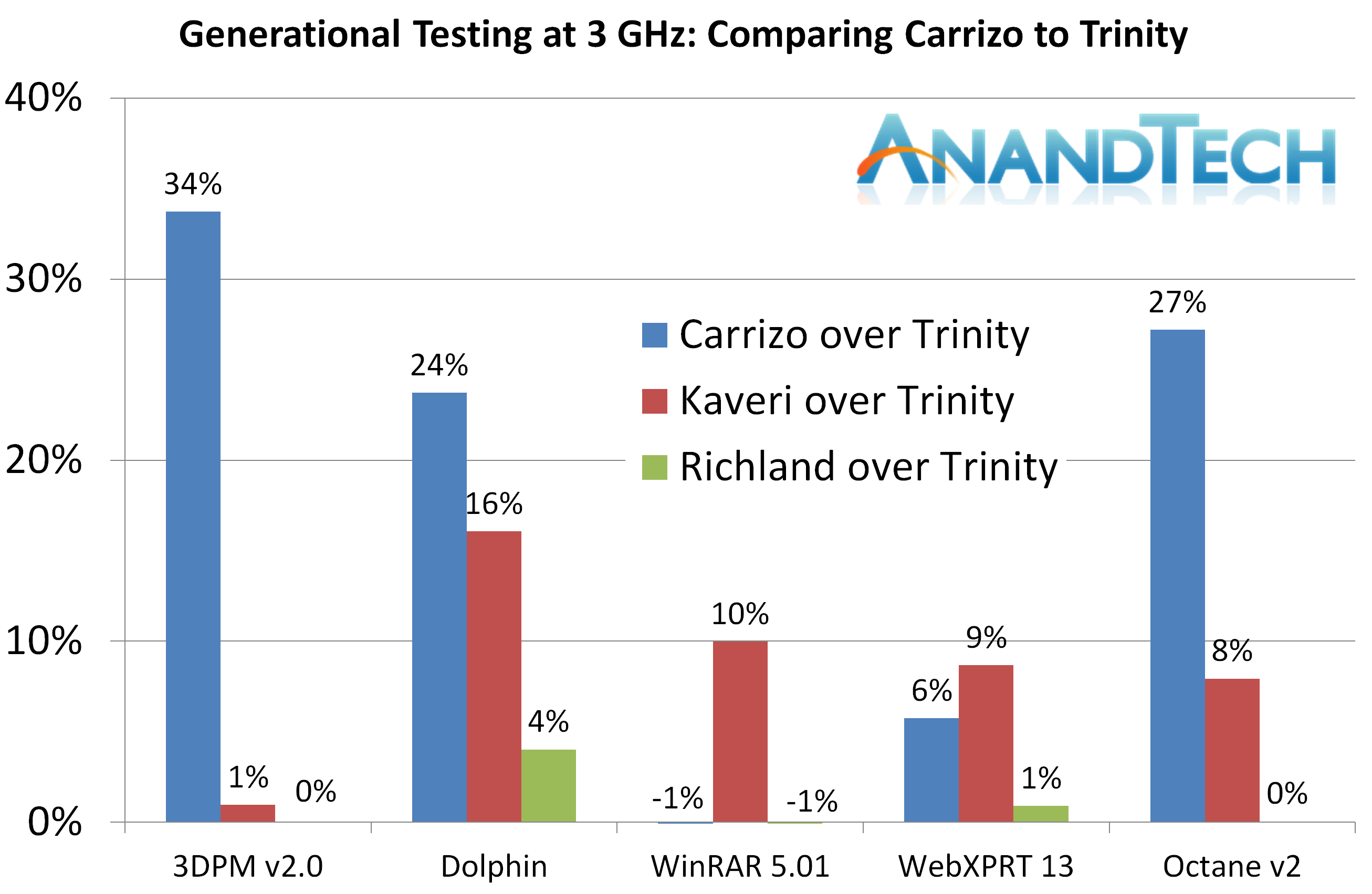
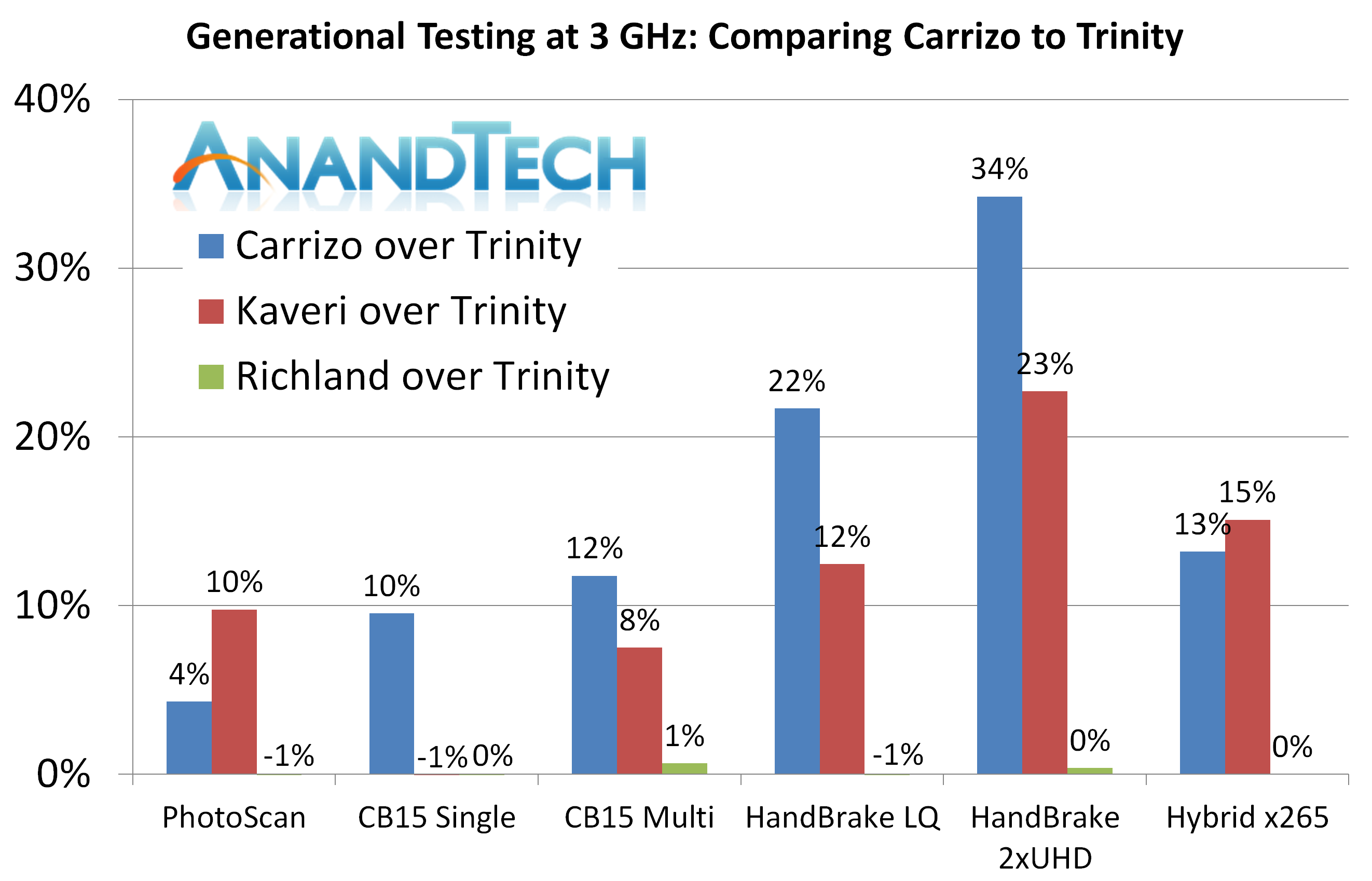
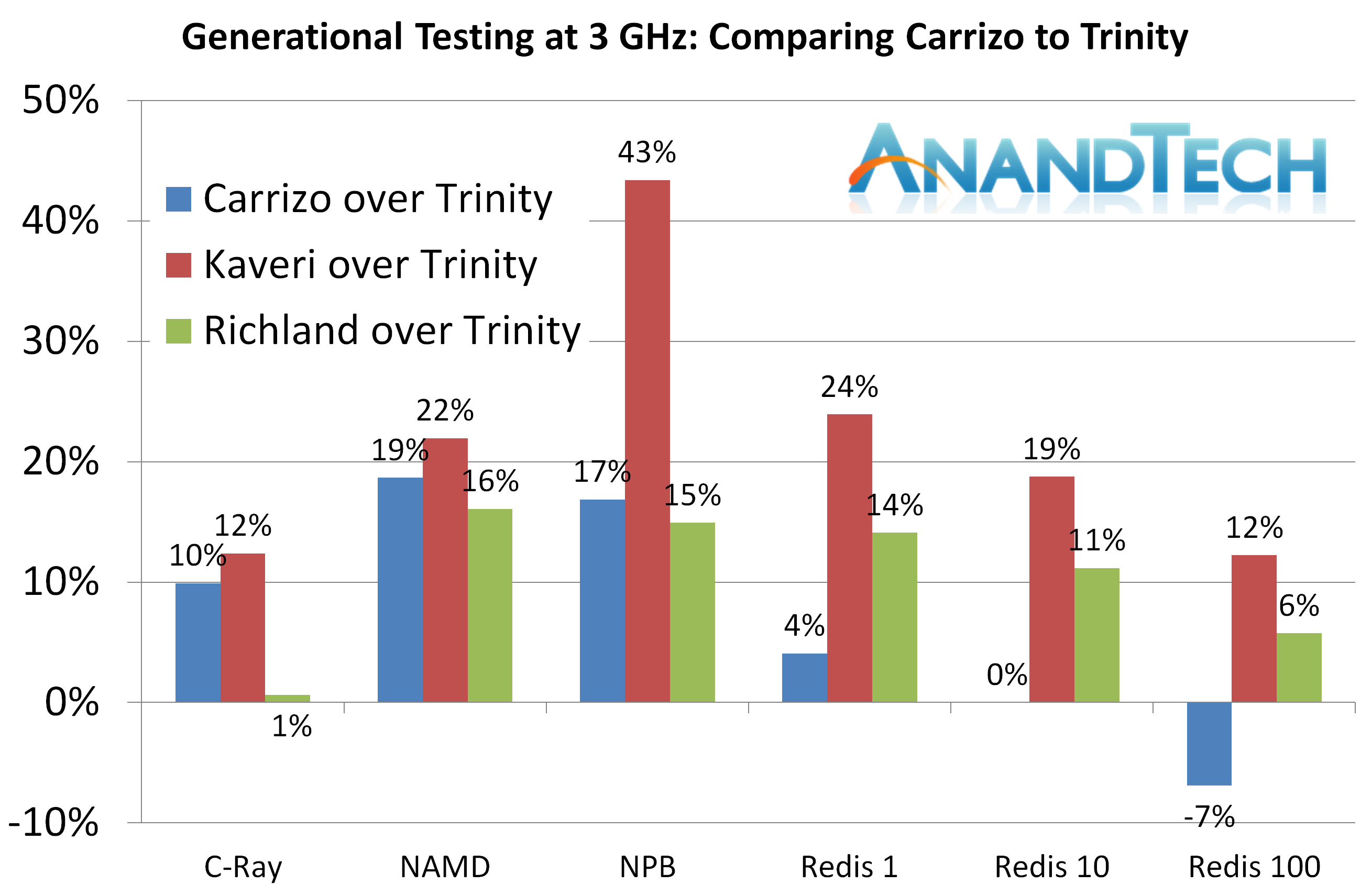
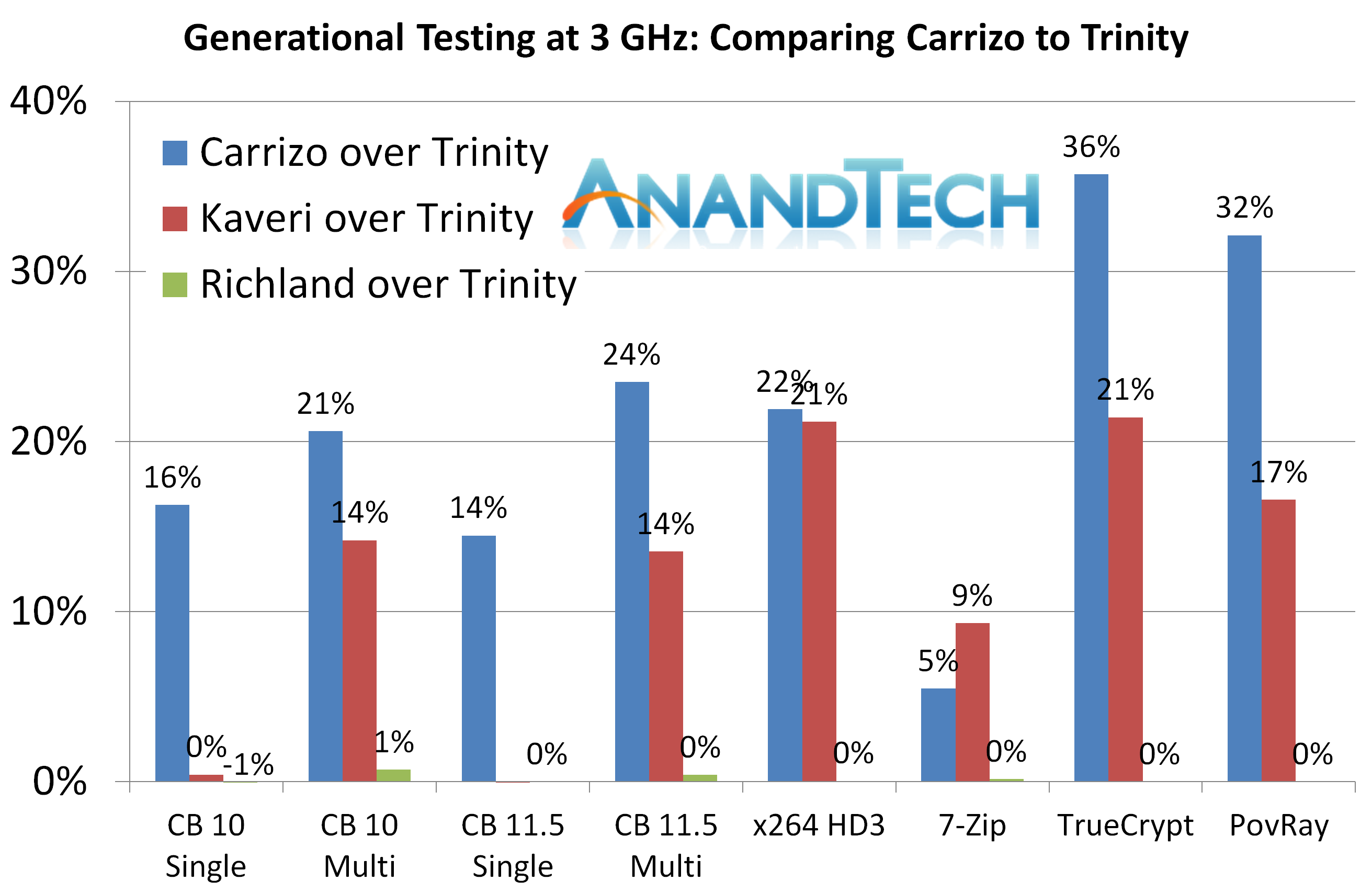

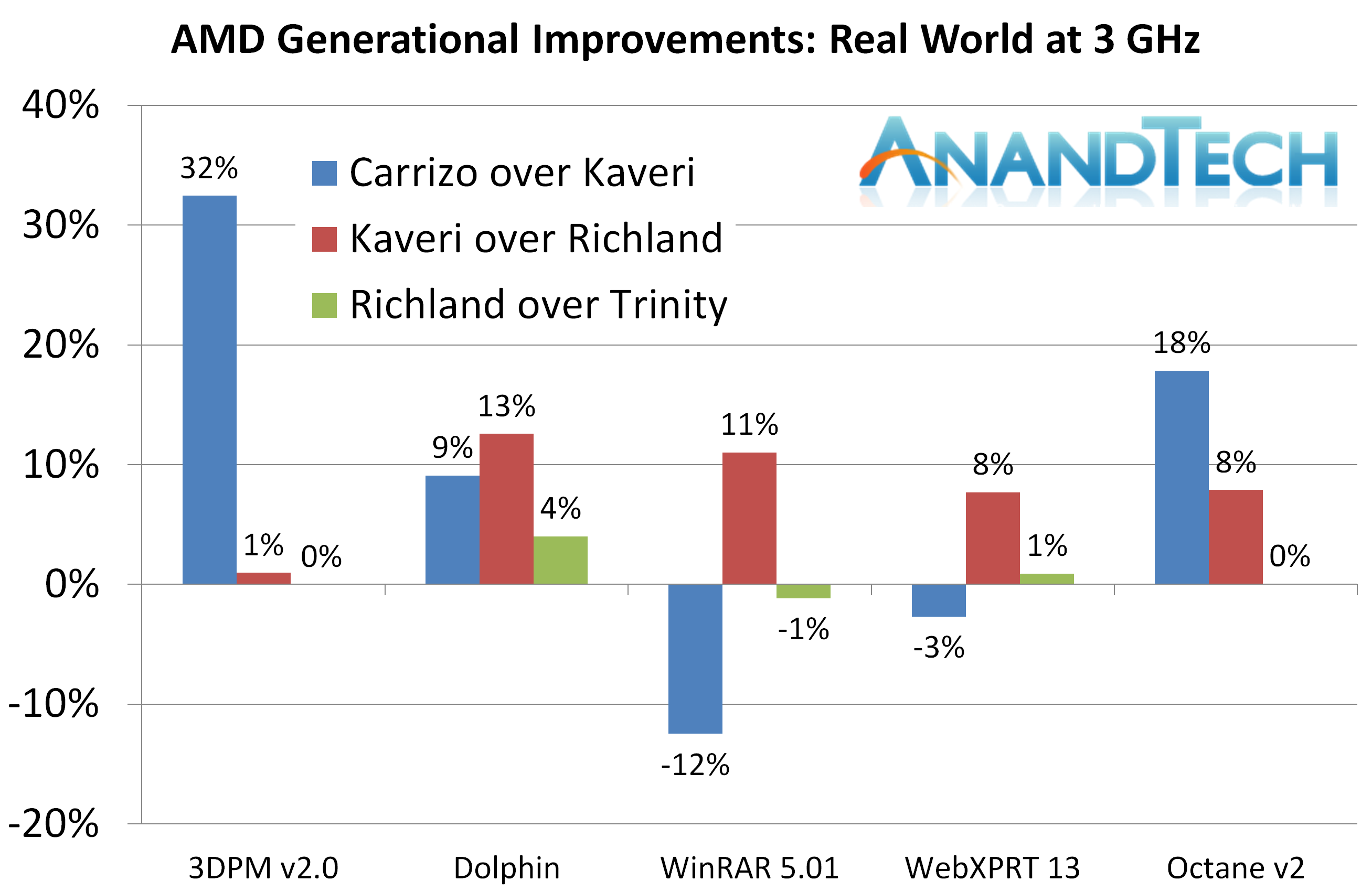


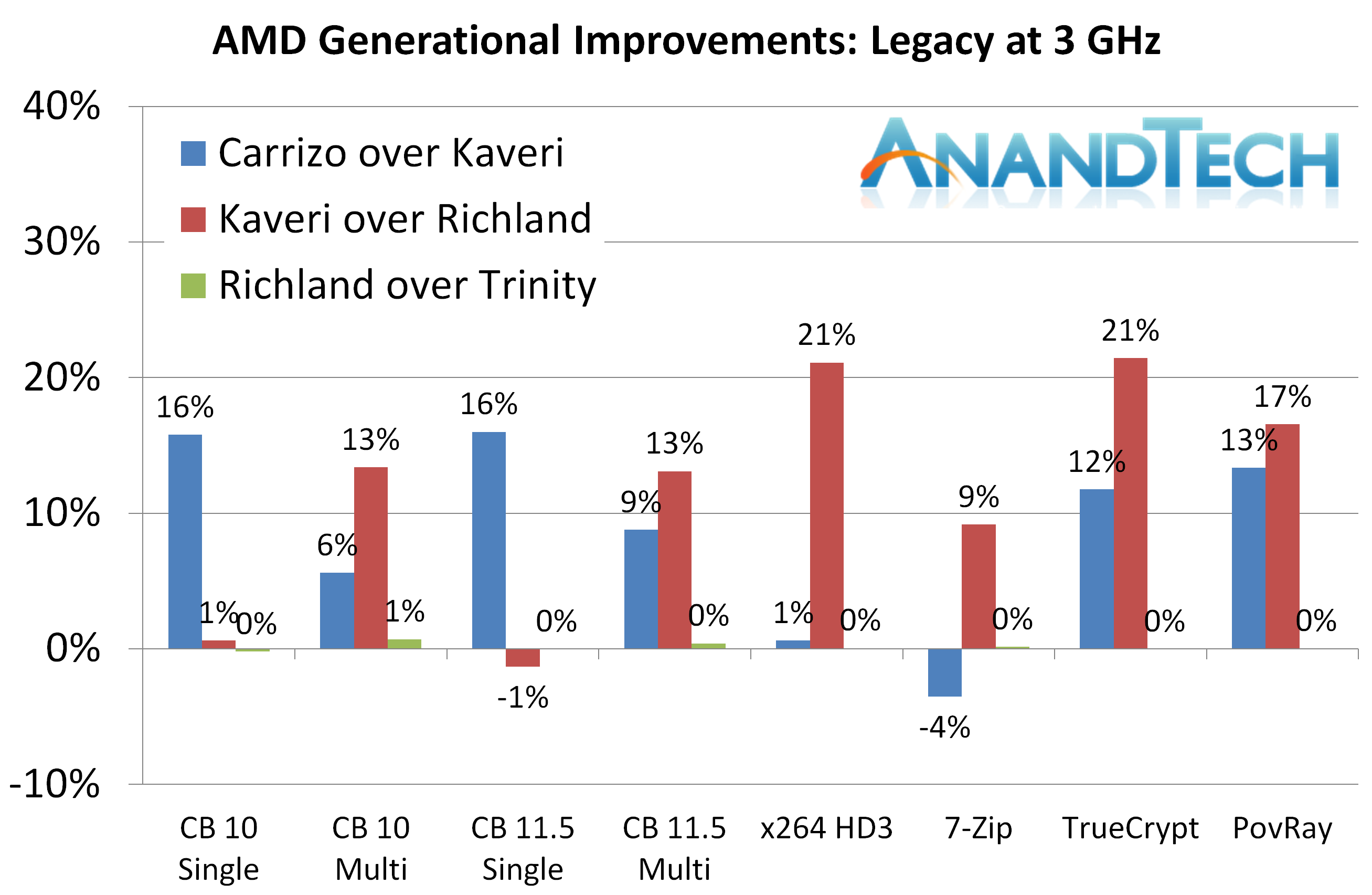
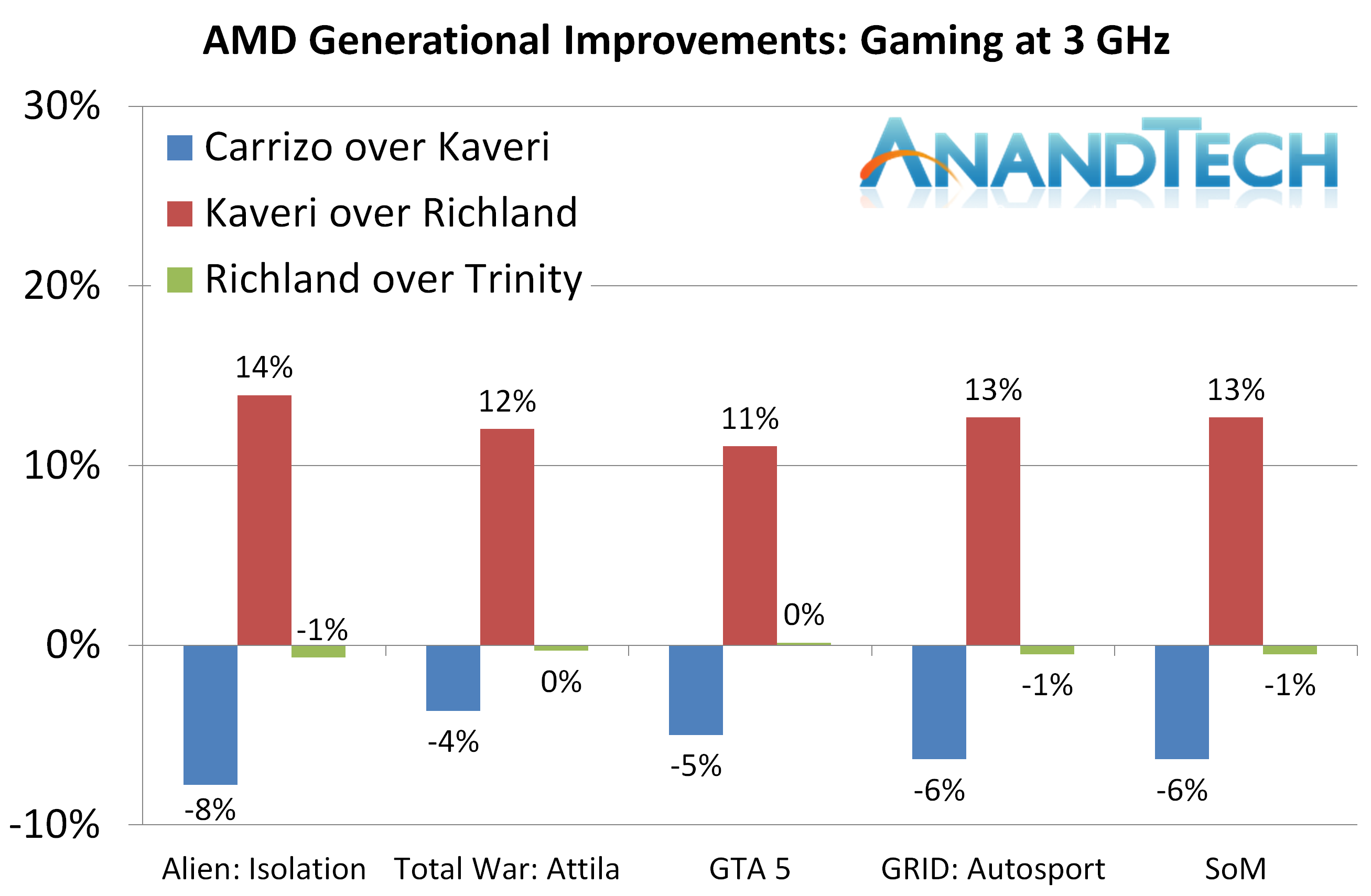








131 Comments
View All Comments
owan - Thursday, July 14, 2016 - link
A nice little pop over the previous generation and its still woeful compared to its direct competition from intel. I wonder why AMD even bothered with this product, Intel has a complete stranglehold on the mobile market and AMD's design wins are few and far between. Surely some of the architectural changes could have been rolled into a replacement for their incredibly stale AM3+ products, which have by now become completely irrelevant. I mean, we all know Zen is coming (and I hope its good) but something in the meantime would probably have done more for their mind share than a mobile part.AndrewJacksonZA - Thursday, July 14, 2016 - link
"I wonder why AMD even bothered with this product"Yeah, pretty much what I've been thinking with AMD's CPU launches for a while now. *Surely* they can't be making money on their CPUs compared to how much they spend on researching, testing, producing and then marketing them?
(Unless there's a market that's low-profile in the media but is lucrative for AMD - perhaps the low budget market in Asia?)
patel21 - Thursday, July 14, 2016 - link
I'm from Asia, India. And here too people are smart enough to ignore AMD even in really low budget systems. And really we still have a complete PC with P4 or C2D easily available around 100$jospoortvliet - Thursday, July 14, 2016 - link
Compared to a p4 these amd cpu's are amazing... remember that in the time of the P4, amd made the faster more power efficient cpu's.mr_tawan - Friday, July 15, 2016 - link
P4 or C2D are worse than every current AMD cpus on the market .... in one or another aspect.BlueBlazer - Friday, July 15, 2016 - link
It is called "progress". Both Intel Pentium4 and Intel Core 2 Duo are already out of production years ago. Also it was Intel's Core 2 Duo that blew away AMD back into the stone age a decade ago, and since then AMD has never recovered. AMD's QuadFather FX and Barcelona (especially the TLB bugged ones) are the worst CPUs of their era (quite often was much slower than previous generation overall).bananaforscale - Friday, July 15, 2016 - link
P4? Ew. :P (I have a P4D in the other room, it's not really preferable to anything. That if anything is a dead end.)nandnandnand - Thursday, July 14, 2016 - link
AMD is good in laptops. It will be better when Zen is out. Zen on the desktop may be good depending on the benchmarks and price.mr_tawan - Friday, July 15, 2016 - link
I'm from Asia, Thailand. AFAIK AMD is pretty popular among internet cafe' (or should I say... game center instead ?).BlueBlazer - Friday, July 15, 2016 - link
Over here, hardly see AMD being used in internet cafes.